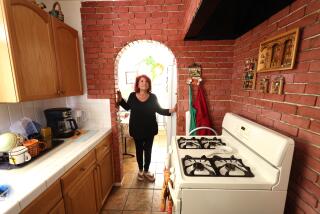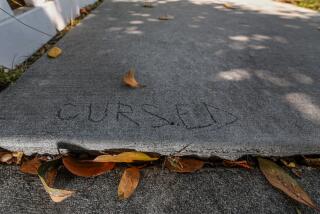Turnout Is Fair Play in Dealing With Rubber Neckers
- Share via
Dear Street Smart:
It really disturbs me that when a Highway Patrol officer pulls someone over on the freeway to issue a ticket, all the looky-loos immediately start slowing down to gawk and the domino effect slows traffic behind them.
Why can’t the CHP use the patrol car’s public address system to instruct people who are going to get a ticket to pull over at the next exit? That would take them off the freeways and avoid attracting looky-loos.
Mel Green, Glendale
Dear Reader:
Looky-loos sound benign enough. That could be the name of a cream-filled chocolate cake sold at 7-Eleven stores next to the Ding Dongs and the Twinkies.
But they are not a snack, they are one of the most frustrating commuter problems since the flat tire. Some people know them as gawkers or rubber neckers.
California Highway Patrol Officer Glen Dominguez said the CHP does use the patrol car’s PA system to instruct cars to leave the freeway whenever possible to issue tickets. But that doesn’t always work, either because the driver doesn’t understand the directions or because the CHP thinks it’s safer to pull the car over on a wide shoulder, he said.
However, Caltrans may provide some relief. On the Santa Monica Freeway, Caltrans has installed a dozen turnout areas that are shielded from traffic by a screened fence. These turnouts, called “Accident Investigation Sites,” are places where you can stop to deal with car problems or fender-benders. The CHP is also using them to issue tickets.
If the concept works, Caltrans spokesman Russell Snyder said “Accident Investigation Sites” will be added to other freeways throughout the state.
Maybe then looky-loos will concentrate on what is just beyond their hood ornament instead of what happens on the freeway shoulders.
*
Dear Street Smart:
Can you explain why the nozzles for Arco’s EC-1 gasoline and Thrifty’s regular grade are too large for the gas tanks in late model cars? Both products are unleaded and are just about the least expensive gasoline available. However, those of us who drive newer cars can’t use them.
Harold N. Bass, Northridge
Dear Reader:
The nozzles are purposely made extra large so that you can’t put those gasolines in your car. It’s the same concept as when toys are made too big to fit in a child’s mouth. Think of this as an adult-proof nozzle.
Even though EC-1 and Thrifty’s regular grade are unleaded gasolines, they were designed as substitute fuel for those pre-1975 vehicles that once ran on leaded gasoline, because it is now illegal to sell leaded gas in this state.
Arco spokesman Tom Butler said EC-1 is specially formulated to reduce pollution generated by these older cars. Arco does not sell the fuel to everyone because Arco can only make a limited supply, he said.
And although EC-1 is about as cheap as its leaded counterpart, it costs more to make and so Arco would rather keep sales to the minimum needed to supply those older cars with less-polluting fuel.
But let’s say that due to some uncontrollable urge, you manage to cram that EC-1 nozzle into your new car’s tank and fill up. The gas will probably not harm your engine. Your car will operate pretty much as usual. The only harm will come when the gas station attendant finds out what you did to get his nozzle in your tank.
*
Dear Street Smart:
I am a 76-year-old bicycle rider and I believe that with a minimum of financing Los Angeles could make four bike lanes along the river, two on the top rim and two down in the bed. When weather threatened, the gates could be closed and locked. There could be a phone number to see if the gates are closed.
Jack T. Elliott, North Hollywood
Dear Reader:
Good idea, Jack, but there is no need to peddle it further.
You see, the city of Los Angeles already has plans for a bicycle path on the river’s rim from North Hollywood to downtown Los Angeles.
Construction on the first 3-mile section between Los Feliz Boulevard and Zoo Drive will begin in December or January. City engineers plan to complete the entire 16-mile, $5.1-million river-side bike path in phases over the next six years or so.
In fact, Irwin Chodash, a city engineer who oversees the bike path, said the city plans to put gates along the path so it can be closed off when flooding threatens.
Unfortunately, he thought the idea of river-bottom bike lanes was all wet. He said river flooding would make it unsafe, and then there is all that river debris that would continually pile up on the path.
All that aside, the path still needs a name. What about “the Waterway Pedal Way” or “The Concrete Concourse?” Maybe the city can sponsor a race on the path. Call it “The Tour de Flood Channel.”
*
Dear Street Smart:
I live in Reseda and I often have to drive on Reseda Boulevard to get to the Ventura Freeway. For years, the railroad tracks crossing Reseda Boulevard near Oxnard Street has not been maintained. I often resort to taking Tampa Boulevard just to avoid the annoyance of driving over these bumps across the railroad tracks.
I cannot understand why the city has not fixed this problem.
Duc N. Tu, Reseda
Dear Reader:
It’s not the city’s problem. It’s the Southern Pacific railroad’s problem. But in a few years it’s going to be Los Angeles county’s problem.
Let me give you a little background to make this clear.
In 1991, the Los Angeles County Transportation Commission bought the rail rights of way parallel to Burbank and Chandler boulevards from Southern Pacific to build a mostly subway mass-transit line across the San Fernando Valley. These are the same tracks that give your car’s suspension such a hard time.
But there is a debate about whether to go ahead with that plan or to build an elevated line over the Ventura Freeway instead. A decision will come sometime next year.
In the meantime, Southern Pacific has paid to continue using some stretches of the tracks, including the sections around Reseda Boulevard and further west. The railroad company is responsible for maintaining the tracks it uses and the narrow strip of pavement where they intersect city streets. So, call them at (415) 541-1652 and ask them to smooth out the bumps.
As for the future of the railroad rights of way, there are some transportation officials who would like to tear out the tracks and use the land for a greenbelt with bike paths and walking trails. A subway could always be built beneath the greenbelt if that plan was chosen.
Come to think of it, the proposed greenbelt doesn’t have a name either. I suggest “the Rail Trail” or “In the Train’s Path.”
The city can also sponsor a foot race called “the Railway Relay.”
Try saying that three times fast.
More to Read
Sign up for Essential California
The most important California stories and recommendations in your inbox every morning.
You may occasionally receive promotional content from the Los Angeles Times.











